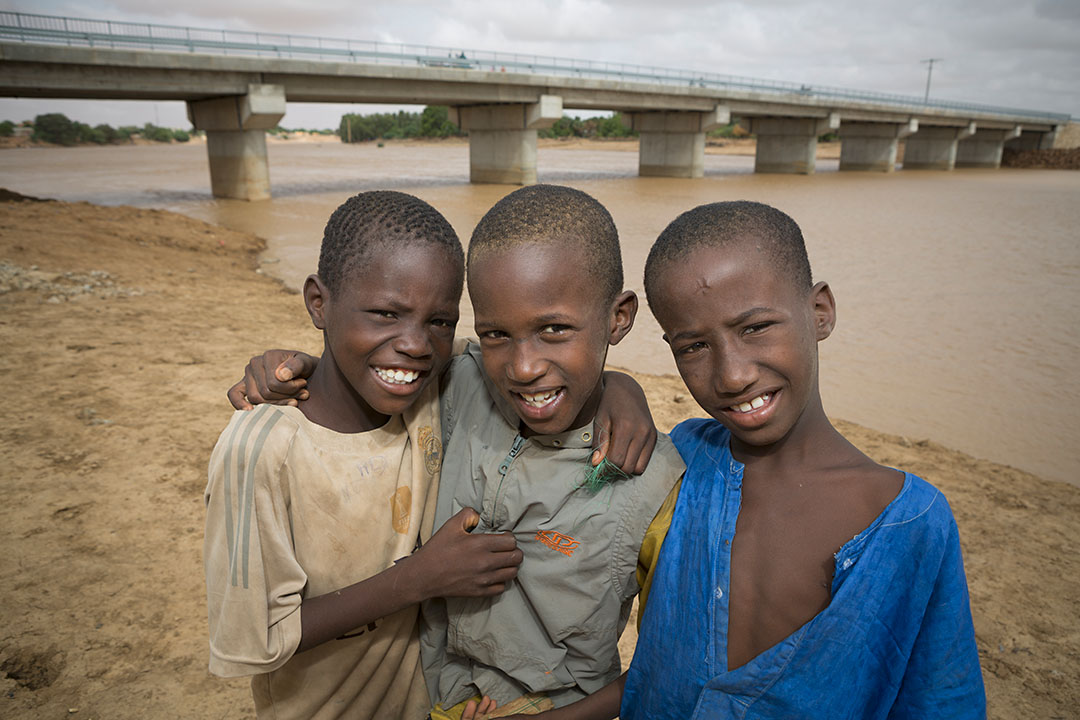The island in northern Senegal is separated from the mainland town of Ndioum by a roughly 160-meter-wide river. Two existing bridges connect the island to the mainland, but because they are far from Ndioum, most residents used a ferry or wooden canoes to cross the river.
Yet, about five people drowned each month, according to a local gendarmerie officer, from falling off the ferry and capsizing their canoes.
Farmers on the island couldn’t effectively get their goods to markets, students needed to cross the river to reach post-primary schools, and more advanced health centers were difficult to reach on the mainland.
“It was always difficult before. There were never enough canoes, and the ones that were there were always overcrowded,” said Bably Dioum, a teacher who traveled to work from the island to the mainland by canoe every day.
Today, all those concerns are in the past. The Millennium Challenge Corporation, as part of its five-year, $540 million compact with Senegal, financed the construction of the Ndioum Bridge – which links the island to the mainland, and fertile farm fields with key markets throughout the region.
“The bridge makes crossing much, much safer now,” said Guedj Siga, an officer of the Ndioum gendarmerie. Someone drowned just a week before the bridge was completed, he said, but none have drowned since.

Jake Lyell for MCC
From left, Ainadou, Moustapha and Sulaye stand in front of the Ndioum bridge, which spans the Doué River and connects the town of Ndioum to Morphil Island.
For the residents of Ile de Morphil, the opening of the MCC-funded bridge is a development seven decades in the making. Year after year, residents petitioned their governments to build a bridge. The first request was sent to French colonial authorities in 1944. In the decades that followed, promises were made but never kept.
“Seventy years later—thanks to the American and Senegalese governments—we finally have this bridge,” said Oumar Diaw, first deputy mayor of Ndioum.
Diaw is a lifelong resident of Ndioum and a famers’ association president. The vast majority of the people in the area rely on agriculture to make a living, he said. Like other farmers, he relied on canoes to get his products to markets on the other side of the river.
MCC’s $325 million Roads Rehabilitation Project, which includes the Ndioum Bridge, aimed to increase access to major national and international markets for Senegalese farmers and businesses. In the north, MCC rehabilitated the 75-mile RN2 highway – a key link between Senegalese cities and markets in Mauritania and Mali – to stimulate regional trade.
Adama Dia, a rice and tomato farmer, often waited at the banks of the river for five hours for a canoe or ferry—and at a price of more than $16. Dia, 20, now negotiates the price of his crops up front, and a truck comes across the bridge to fetch his supply.
“We can work longer hours, produce more, sell more,” he said. “This has transformed all of our businesses.”
For one resident, the sight of workers loading crops from his farm fields in northern Senegal onto cargo trucks still seems like a mirage.
"This is all new, and it's all because of the wonderful bridge," said Abdoulaye Dioulde Wane, who grows rice, okra, peppers and onions.
Dioum, the teacher who traveled to work by canoe every day, sees the new bridge as a historic moment for the community.
“It’s not debatable. This will be a better future for our children,” he said. “It was the wish of our ancestors to have this bridge.”
On both sides of the river, residents believe the bridge is the start of a new era of opportunity—as well as a lasting symbol of the American-Senegalese partnership.
“It’s such an important development for us,” said Wane. “I don’t have words to describe it. There is no pen that can write and no words that can describe what that means to us.”

